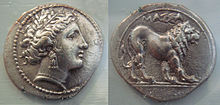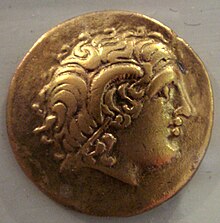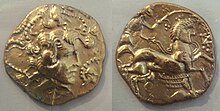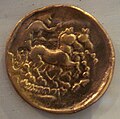| Revision as of 20:53, 3 July 2010 edit77.109.206.220 (talk)No edit summary← Previous edit | Revision as of 20:54, 3 July 2010 edit undoJeff G. (talk | contribs)Autopatrolled, Extended confirmed users, File movers, IP block exemptions, New page reviewers, Pending changes reviewers, Rollbackers116,602 editsm Reverted edits by 77.109.206.220 (talk) to last revision by Per Honor et Gloria (HG)Next edit → | ||
| Line 54: | Line 54: | ||
| ==See also== | ==See also== | ||
| * ] | |||
| * ] | * ] | ||
| ==Gallery== | ==Gallery== | ||
Revision as of 20:54, 3 July 2010

The Greeks in pre-Roman Gaul have a significant history of settlement, trade, and cultural influence in the Celtic territory of Gaul (modern France), starting from the 6th century BCE during the Greek Archaic period. Following the founding of the extensive trading post of Massalia in 600 BCE by the Phocaeans in present day Marseille, hellenization spread amongst the philhellenic Celtic tribes in Gaul.
Settlement at Marseille (600 BCE)




The oldest city within modern France, Marseille, was founded around 600 BCE by Greeks from the Asia Minor city of Phocaea (as mentioned by Thucydides Bk1,13, Strabo, Athenaeus and Justin) as a trading post or emporion under the name Μασσαλία (Massalia).
A foundation myth reported by Aristotle in the 4th century BCE as well as by Latin authors, recounts how the Phocaean Protis (or Euxenus) married Gyptis (or Petta), the daughter of a local Segobriges king called Nannus, thus giving him the right to receive a piece of land where he was able to found a city. The contours of the Greek city have been excavated, in the modern quarters of Saint-Blaise and Saint-Marcel. The Phocaean Greeks introduced the cult of Artemis, as in their other colonies.
It is thought that contacts started even earlier however, as Ionian Greeks traded in the Western Mediterranean and Spain, but only very little remains from that earlier period. Contacts developed undisputedly from 600 BCE, between the Celts and Celto-Ligurans and the Greeks in the city of Marseille and their other colonies such as Agde, Nice, Antibes, Monaco, Emporiae and Rhoda. The Greeks from Phocaea also founded settlements in the island of Corsica, such as at Alalia. From Massalia, the Phocaean Greeks also founded cities in northeastern Spain such as Emporiae and Rhoda.
Before the Greeks came to pre-eminence in the Gulf of Lion, trade was mainly handled by the Etruscans and the Carthaginians. It is thought that the Greeks of Massalia defeated the Gauls and the Ligurians, defeated the Carthaginians in the late 6th century (Thucydides 1.13) and probably in 490 BCE, and soon entered into a treaty with Rome.
According to Charles Ebel, "Massalia was not an isolated Greek city, but had developed an Empire of its own along the coast of southern Gaul by the fourth century". Greek Marseille was a centre of culture which drew philhellenic Celts from the surrounding area, eager to learn the Greek language and worship at its temples. The hellenization of Southern France prior to the Roman Conquest of Transalpine Gaul is thought to have been largely due to the influence of Massalia.
Greek trade in Gaul

These eastern Greeks, established on the shores of southern France, were in close relations with the Celtic inhabitants of France, and Greek influence and artifacts penetrated northwards alongs the Rhône and Saône valleys as well as the Isère. Phocaean grey bucchero pottery has been discovered in the Hautes Alpes and as far north as Lons-le-Saunier, as well as three-winged bronze arrowheads as far as northern France, and amphorae from Marseilles at Mont Lassois. The site of Vix in northern Burgundy became an active trading center between Greeks and natives, testified by the discovery of rich Greek artifacts of the period.
From Marseille, maritime trade also developed with Languedoc and Etruria, and with the Greek city of Emporiae on the coast of Spain. Massalia traded as least as far as Gades and Tartessus on the western coast of the Iberian peninsula, as described in the Massaliote Periplus, although this trade was probably blocked by the Carthaginians at the Pillars of Hercules after 500 BCE.
The mother city of Phocaea would ultimately be destroyed by the Persians in 545, further reinforcing the exodus of the Phocaeans to their settlements of the Western Mediterranean. Trading links were extensive, in iron, spices, wheat and slaves. A trade in tin, indispensable for the manufacture of bronze, seems to have been established at that time between Cornwall in modern England, through the Channel, and along the Seine valley, Burgundy and the Rhône-Saône valleys to Marseille. The Greek settlements permitted cultural interaction between the Greeks and the Celts, and in particular helped develop an urban way of life in Celtic lands, contacts with sophisticated Greek methods, as well as regular East-West trade.
Legacy


Overland trade with Celtic countries declined around 500 BCE however, with the troubles following the end of the Halstatt civilization. The site of Mont Lassois, where trade had thrived between Celts and Greeks was abandoned around that time.
The Greek colony of Massalia remained active in the following centuries. Around 325 BCE, Pytheas (Ancient Greek Πυθέας ὁ Μασσαλιώτης) made a voyage of exploration to northwestern Europe as far as the Arctic Circle from his city of Marseilles. His discoveries contributed to the elaboration of the ancient world maps of Dicaearchus, Timaeus and Eratosthenes, and to the development of the parallels of latitude.
The La Tène style, based on floral ornamentation in contrast to the geometric styles of Early Iron Age Europe, can be traced to imported object of Greek or Etruscan origin.
During his conquest of Gaul, Caesar reported that the Helvetii were in possession of documents in the Greek script, and all Gaulish coins used the Greek script until about 50 BCE.
Influence on Gaulish coinage


Celtic coinage emerged in the 4th century BCE, and, influenced by trade with and the supply of mercenaries to the Greeks, initially copied Greek designs. Celtic coinage was influenced by Greek designs, and Greeks letters can be found on various Celtic coins, especially those of Southern France. Greek coinage occurred in three Greek cities of Massalia, Emporiae and Rhoda, and was copied throughout southern Gaul.
Northern Gaul coins were especially influenced by the coinage of Philip II of Macedon and his famous son Alexander the Great. Celtic coins often retained Greek subjects, such as the head of Apollo on the obverse and two-horse chariot on the reverse of the gold stater of Philip II, but developed their own style from that basis, allowing for the development of a Graeco-Celtic synthesis.
After this first period in which Celtic coins rather faithfully reproduced Greek types, designs started to become more symbolic, as exemplified by the coinage of the Parisii in the Belgic region of northern France. By the 2nd century BCE, the Greek chariot was only represented by a symbolic wheel.
The Armorican Celtic style in northwestern Gaul also developed from Celtic designs from the Rhine valley, themselves derived from earlier Greek prototypes such as the wine scroll and split palmette.
With the Roman invasion of Gaul, Greek-inspired Celtic coinage started to incorporate Roman influence instead, until it disappeared to be completely replaced by Roman coinage.
By the 1st century BCE, the coinage of the Greeks of Marseille circulated freely in Gaul, also influencing coinage as far afield as Great Britain. The coins of the Sunbury hoard, thought to have been manufactured in Kent, show designs derived from Greek coins from Marseille with the stylised head of Apollo and a butting bull.
See also
Gallery
-
 Massalia coins, 5th-1st century BCE
Massalia coins, 5th-1st century BCE
-
 Emporiae coins, 5th-1st century BCE
Emporiae coins, 5th-1st century BCE
-
 Rhoda coins, 5th-1st century BCE
Rhoda coins, 5th-1st century BCE
-
 Gold coin of the Sequani, 5th-1st century BCE
Gold coin of the Sequani, 5th-1st century BCE
-
 Celtic coin designs progressively became more abstract as exemplified by the coins of the Parisii
Celtic coin designs progressively became more abstract as exemplified by the coins of the Parisii
-
 Coin of the Santones Gauls, 5th-1st century BCE
Coin of the Santones Gauls, 5th-1st century BCE
-
 Coin of the Santones Gauls, 5th-1st century BCE
Coin of the Santones Gauls, 5th-1st century BCE
-
 Detail from Vix krater: frieze of hoplites and four-horse chariots on the rim
Detail from Vix krater: frieze of hoplites and four-horse chariots on the rim
Notes
- ^ The Cambridge ancient history p.754
- ^ A history of ancient Greece Claude Orrieux p.62
- The Celts: a history by Raithi O Hogain, p.27
- A Companion to the Classical Greek World Konrad H. Kinzl p.183
- ^ Transalpine Gaul: the emergence of a Roman province by Charles Ebel p.10-
- The western shores of Turkey: discovering the Aegean and Mediterranean coasts by John Freely p.91
- ^ A history of ancient Greece Claude Orrieux p.61
- Transalpine Gaul: the emergence of a Roman province by Charles Ebel p.2
- ^ The European Iron Age by John Collis p.144 ff
- King 1990, pp. 11–33, Chapter I, "Greeks and Celts"
- Ireland and the classical world by Philip Freeman p.32
- The History of Cartography John Brian Harley p.150
- The ancient mariners Lionel Casson p.74
- ^ A history of ancient Greece Claude Orrieux p.63
- A history of ancient Greece Claude Orrieux p.65
- ^ Boardman, p.308
- The History of Cartography by John Brian Harley p.150
- ^ The hellenistic world by Frank William Walbank p.205
- The History of Cartography John Brian Harley p.150-
- European prehistory: a survey Sarunas Milisauskas p.354
- The archaeology of late Celtic Britain and Ireland, c. 400-1200 AD Lloyd Robert Laing p.342
- ^ Celtic culture: a historical encyclopedia" John T. Koch p.461-
- Celtic Inscriptions on Gaulish and British Coins" by Beale Poste p.135
- Museum of London exhibit
References
- Boardman, John (1993), The Diffusion of Classical Art in Antiquity, Princeton University Press, ISBN 0691036802
- Ebel, Charles (1966), Pre-Roman Greeks in Gaul, University of Iowa
- King, Anthony (1990), Roman Gaul and Germany, University of California Press, ISBN 0520069897